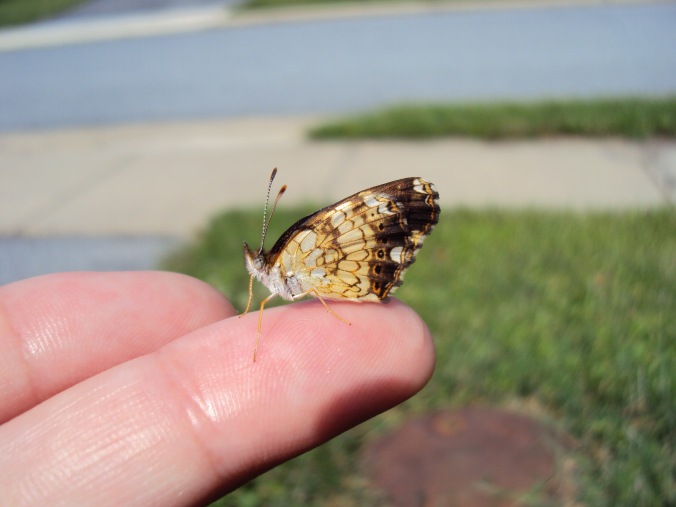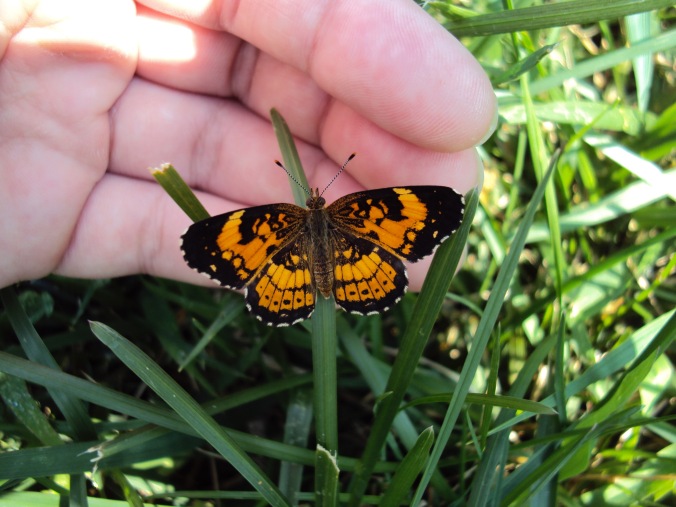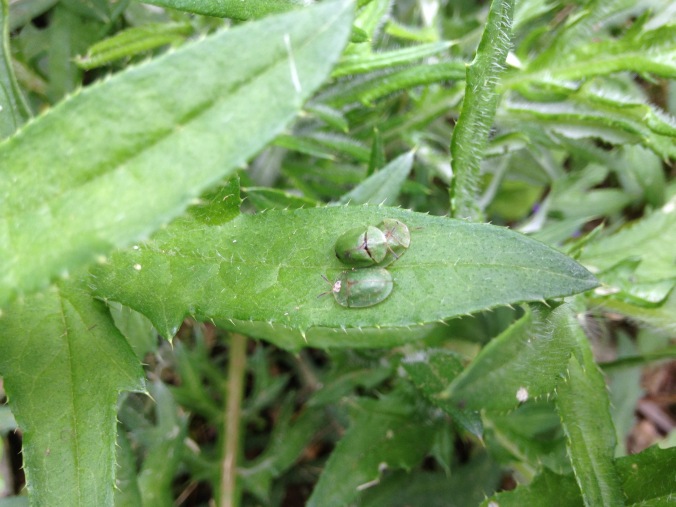I like to say that the difference between what I’m into and, like, normal gardening is that I get excited when I find insect damage.
Well. That’s only mostly true.
Here’s one of the hooray-for-defoliation stories:
Silvery checkerspots are kind of symbolic for me. They were the second species I’d ever reared to adulthood – back in 2014, the summer of the accidental (and accidentally great) pond and the genesis of my current bug-and-bird-focused approach to gardening in general.

Fun fact: notice how it looks like it’s only got four legs? That’s a characteristic of brushfoot butterflies (the family Nymphalidae). They do have all six, but the front two are vestigial.

Other fun fact: I am waaaaay too into taking macro shots of plants and bugs. Especially since I lack the gear to make a decent job of it in most situations.
But I haven’t spotted them in three years. The adults are plenty common around here, so I figured they’re probably still breeding on my plants, but I’m trying to keep a more accurate records of adult/caterpillar sightings to use for host plant decisions, and not having unambiguous confirmation irks me.
So yep, I was pretty darn excited to finally catch them in action again. They almost completely stripped a couple of my plants before starting to pupate, and the sight fills me with glee.
Insect encounter number two? Not so sure how to feel about this.

This is pasture thistle (Cirsium discolor), another plant I got partly for bug food purposes (Painted Lady, crossing my fingers there), so when I noticed it seemed to be getting a lot of insect activity I got excited and then went to ID these little beauties. They’re not caterpillars, but they’re still bugs, right? So they’re still supporting local food webs, right?
…Yeah, sort of. Meet the thistle tortoise beetle, Cassida rubiginosa. Native to Eurasia.
SIGHHHH. I know that being a die-hard native purist is not a super helpful or practical stance, and “exotic” doesn’t necessarily translate to “EVIL MURDER BUG DESTROYS ECOSYSTEMS WHILE CACKLING MANIACALLY.” And ok also I really, really don’t like killing things – even just bugs, even destructive non-native bugs. I have a hard enough time doing it for Japanese beetles, even with the most compelling of reasons, so I’m loath to spend time and stress on another bug crusade.
So I took to google to get a few questions answered:
- Are these beetles currently considered invasive?
- How significant is the impact of their feeding damage on individual plants?
- How well are they kept in check by natural predators? (another way of looking at this: are they a functioning element of local food webs?)
Gratuitous science nerding and ambiguous results follow.
- Are these beetles currently considered invasive? Definitely not invasive now. Problematic in the future? Maybe.
The thistle tortoise beetle was deliberately introduced to Virginia at least four decades ago as a biological control for the highly invasive Canada thistle. Most of the articles I was able to find about Cassida rubiginosa are about biocontrol efforts in New Zealand, where it’s a much safer pick:
Although the beetle is oligophagous, with many host plants in the Cardueae tribe, its release as a biological control agent was considered safe since there are no native Cardueae plants in NZ, and potential damage to economic plants (e.g. artichoke) was considered acceptable in cost-benefit analyses. In its native range, at least 21 Cardueae species have been recorded as host plants, most belonging to the subtribe Carduinae (true thistles); however, the beetle shows a marked preference for C. arvense, which is considered its primary host. [x]
In the US, on the other hand, it doesn’t always come recommended [x]. The degree of host specialization is really important when you’re looking at introducing an exotic biocontrol organism. The vast majority of herbivorous insects are plant specialists to some degree, but some are more restricted than others: eastern black swallowtail happily feeds on a wide variety of plants in Apiaceae, the carrot family, whereas monarchs can only eat plants in a single genus, Asclepias, i.e. milkweeds. Introduce a biological control whose appetite is broader than needed, and you end up with two invasive species instead of one. This can, and has, happened.
So the beetle’s propensity to transfer to native Cirsium is kind of a concern.
- How significant is the impact of their feeding damage on individual plants? We’ll find out, I guess; I’ll be monitoring and stepping in if necessary.
I’m trying not to get too alarmist about this statistic:
In dry years in Virginia, USA, five parasite-free beetles per plant have been shown to reduce above ground thistle biomass by 88%, and only 25% of plants survived to the end of the following year. In wet years the impact was less but still substantial. [x]
I probably don’t know enough about the botanical differences between Canada and pasture thistle, or about the conditions measured in this study (farmland? pasture? lawn? what level of competitive pressure and from what plants?) to say whether those results will transfer to my situation. Pasture thistle is only supposed to live about two years or so (whereas Canada thistle is a longer-lived perennial) and these plants are a year old, so I’m not too concerned about repeated feeding shortening the lifespan of the plants. I have swamp thistle (Cirsium muticum) growing in the rain garden, but that’s a biennial too. Maybe I’m being naive, but as long as they all flower and set seed consistently, I think I can live with some damage.
- How well are they kept in check by natural predators/are they a functioning element of local food webs? Definitely predated to some degree.
Tbh I am not nearly good enough with entomology/ecology to have a definitive answer to this. Mostly I just wanted reassurance that something eats these bugs, preferably in significant numbers:
In the field, C. rubiginosa is attacked by several larval parasitoids including Tetrastichus rhosaces and Eucelatoriopsis dimmocki. However, Ang and Kok (1995) felt that parasitism did not limit C. rubiginosa populations in Virginia. Tipping (1993) found that adults released on Canada thistle in Maryland remained in close proximity to the release point and that most oothecae were laid within 1.6 m of the release point. Parasitism in this study was 10.5%, with the most common parasitoid being E. dimmocki. Larvae and pupae are heavily predated by larvae of Coccinella septempunctata L. in Maryland. Spring and Kok (1999) found about 21% overwintering survival of adult C. rubiginosa. [x]
In conclusion? I’ll have to keep an eye on them, and cross my fingers that the ecosystem I’m trying to build around them will help keep populations in check.
And in the meantime I moved all the larvae I could find to a non-native thistle growing in the yard. Eat your heart out, guys.

